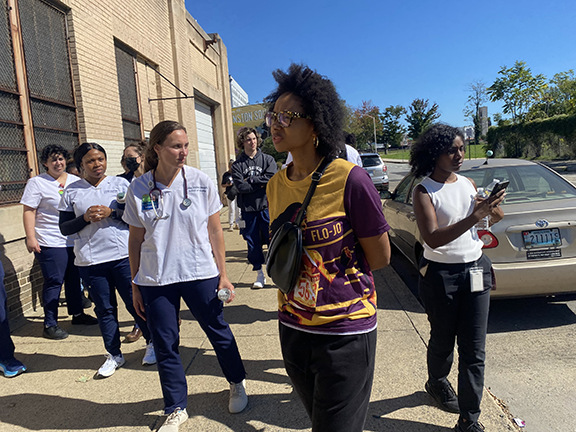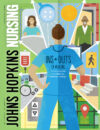On stoops across East and West Baltimore, a revolution in health care is taking place in the most neighborly way possible. Nurses and community workers are going door to door, block by block, face to face in a program designed to personally link every individual in Baltimore neighborhoods to information, prevention, and—where necessary—to health care.
Neighborhood Nursing, driven by Dean Sarah Szanton, PhD, RN, FAAN, co-founder of the successful CAPABLE program to help older citizens age in place, draws inspiration from Costa Rica’s “all in” community-oriented primary health care model. It’s adoption here is born out of a startling imbalance of care in historically underserved areas of Baltimore, a city where 94 percent of residents have health insurance yet disparities remain entrenched. So that’s where efforts begin, meeting people where they live, work, play, and pray and offering, from birth to death, access to a caring person who comes ready to listen, and care.
“I think of what we’re building as like pipes in a water system,” Szanton explained on NPR’s Tradeoffs podcast, “where there’s a resource that’s flowing to every household and that connects them to each other.”
Throughout history, nurses have always gone where the need is. And they’ve used whatever transportation was available to get to more remote places—horseback, canoe, or much later by small plane. In Baltimore, fortunately, feet will do, or maybe an electric scooter. The point is simply getting to every door—homes, schools, libraries, faith-based organizations, barber shops, beauty salons, senior centers and more—and learning what matters most to people.
Throughout history, nurses have always gone where the need is.
Once proven, the efforts would not end until all neighborhoods, rich, poor, white, or ethnically diverse, offer every resident a similar connection. The program is a partnership among schools of nursing at Johns Hopkins, Morgan and Coppin state universities, and the University of Maryland, plus community organizations including Sisters Together and Reaching (STAR). It’s led through JHSON’s Institute for Policy Solutions by Senior Project Manager Lisa Stambolis, RN, CPNP, former director of pediatric and adolescent medicine at Healthcare for the Homeless. (Stambolis worked for Baltimore City Schools for 11 years.)
In two pilot communities, Johnston Square/Oliver (East Baltimore) and Sandtown-Winchester (West Baltimore), the program has paired a nurse and community health worker who visit each person—regardless of their age, health status, or insurance. Access to care (or even health advice) isn’t mandatory. All residents receive an in-person visit, if desired, and are digitally connected with their health care teams for telehealth visits and additional in-person visits based on individual needs. Residents with multiple chronic conditions, young children, or others at higher risk receive more frequent visits, again with their say-so.
The nurse/community health worker teams carry the strategies and skills to support residents and connect them with primary care and social services, while providing “whole person” care on the spot. The idea is that trust will grow, word will spread, and communities will experience decreases in infant mortality, premature death rate, depression, and anxiety, among other important indicators of health and well-being. Vaccination rates should increase.
The Centers for Medicare and Medicaid Services’ Accountable Health Communities Model Evaluation
of 2018–2023 showed that connecting beneficiaries to community resources for health-related social
needs led to a 3 percent reduction in expenditures for Medicaid and a 4 percent reduction for Medicare. Quality of care improved across the board. ◼


